
Meter Box Replacement Project
Meter Replacement Pilot Project
Gateway Services Community Development District has launched an extensive District-wide utility component replacement initiative. This initiative consists of two phases, each starting with pilot projects. The pilot project for meter box replacement has successfully concluded, and the District is now progressing towards full deployment. The pilot project for meter replacement began in summer 2025.
Accommodating Special Needs – Coordinated Scheduling for Temporary Water Service InterruptionsIf you have specific needs, such as requiring uninterrupted access for medical purposes like dialysis, please contact the District to arrange a convenient date and time for the replacement of your meter box.
Meter Box Replacement
Installation of New Meter Boxes
Gateway Services Community Development District has initiated a project to replace meter boxes in preparation for a comprehensive District-wide meter replacement initiative. All work will take place within the utility easement on your property. This is part of a larger underground utility project to replace the District’s metering system. Affected parties, which are District utility customers, will receive notices prior to the commencement of work.
Impact and Restoration:
Temporary water service interruptions (both potable and irrigation) will occur during installation. Landscaping within three feet of the meter box that obstructs work will be cleared and not replaced; affected sod will be restored. After installation, the contractor will inspect the area, address any damage, and perform a water flush to ensure operability of the meters.
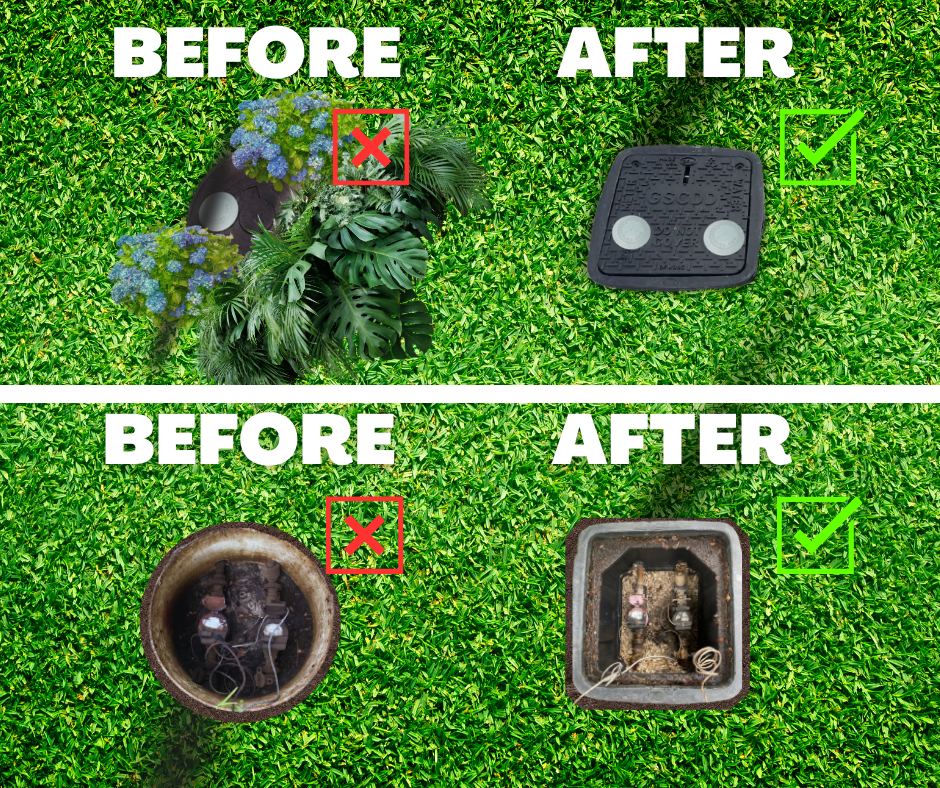
Town Hall Meetings:
The District will host various town hall meetings for each group, as listed in the tentative schedule. The date, time, and location of these town halls will be updated once it becomes available.
Tentative Schedule:
The tentative schedule for the upcoming phases will be updated once more information is available regarding the group commencement of work. Please check back for updates.
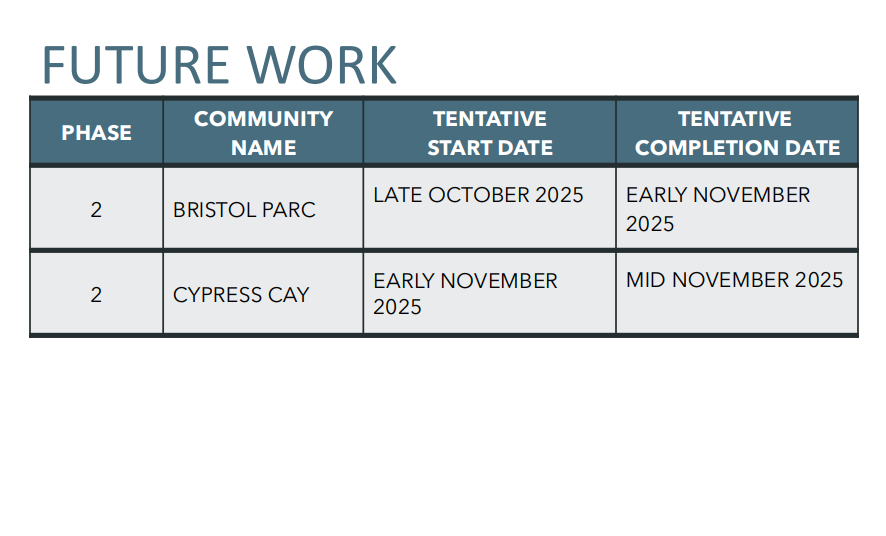
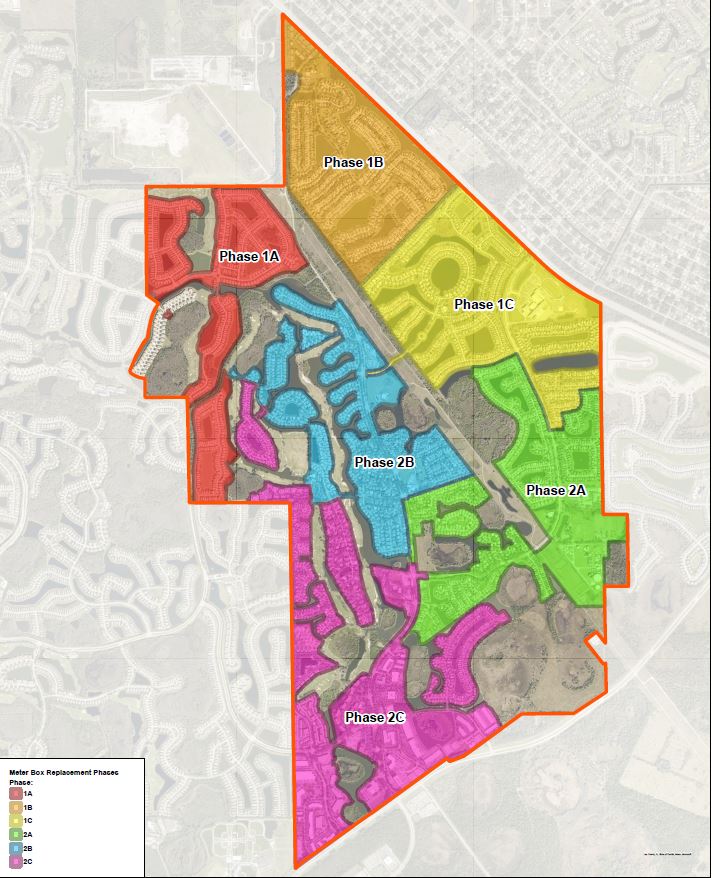
Post‑Work GIS Surveying
As part of the Meter Box Replacement Project, the District will be surveying to collect Geographic Information System (GIS) data for newly installed meter boxes. The surveying is being completed by AIM Engineering and Surveying, who will be onsite collecting location data for the installed meter boxes.
This initial GIS surveying, in the Materita neighborhood, will serve as a pilot survey to ensure accuracy and meet the District’s standards for meter box asset data (type/location). Once this pilot is evaluated, surveying will proceed into other neighborhoods where meter boxes have been installed as part of Phase 1 of the project. Residents in those neighborhoods will receive communication with their confirmed surveying schedule.
Contact Us:
Frequently Asked Questions:
Do I need to be home during the meter box replacement?
No. Since the meter box is located outside, within the utility easement, you will not need to be home for the replacement work. However, the contractor will attempt to contact the property owners up to three times.
When will my meter box be replaced and/or relocated?
Unfortunately, we cannot provide an exact date for your replacement. In most cases, the contractor installs the new meter box directly over the existing one, and the work is typically completed within two to three days, if not sooner.
If work has not yet been completed at your property, please be assured that the contractor will return to finalize the installation, even if they have moved on from your immediate area.
If you have additional concerns, you are welcome to submit a service request for confirmation. However, please know that your property is included in the contractor’s schedule, and the work will be completed.
Will all my group’s boxes be replaced at the same time?
No, the contractor will move down one side of the street, then come back down the other, staying on one side to help with traffic flow.
What should I do to prepare for the meter box replacement?
To ensure the meter box replacement goes smoothly, please ensure there are no obstructions, such as landscaping, plants, or structures, around the meter box. Once the new meter box is installed, any remaining obstructions within three (3) feet of the box will be removed as part of the project. Keeping the area clear will help avoid delays and allow the work to be completed efficiently.
How will I know once my meter box has been replaced?
The contractor will leave a door hanger to notify you when the meter box replacement has been completed.
What happens if I experience a problem after the meter box replacement?
If you experience any issues, such as leaks, low water pressure, or other concerns, please contact the District immediately at (239) 561-1313, option 2.
During the replacement process, your water service may be temporarily interrupted, and you may experience air or discolored water. The contractor will identify an outdoor spigot on your property to perform a water flush.
What are the next steps after the meter box replacement?
Once the meter boxes are replaced, the next phase of the project will focus on replacing the meters themselves. This second phase will involve removing the old meters and installing new, more accurate ones. All work will take place within the utility easement on your property. We will continue to provide updates as the project progresses.
Meter Replacement
Summary:
Gateway Services Community Development District has initiated the next phase of the District’s meter replacement initiative. This pilot meter trial phase is a continuation of the project’s first phase, which focused on the pilot project for meter box replacements. As previously communicated, the same households included in the previous phase will now participate in this next step.
The work for this pilot project will take place within the utility easement on your property. During this process, service(s) provided to your household may be temporarily interrupted.
To communicate work progress, the assigned contractor will leave a door hanger, enclosed for review, when work is scheduled to begin. This hanger will later be flipped to indicate that the work has been completed, including the date of service and property address.
What is the purpose of the District’s meter replacement project?
This project is part of the District’s long-term infrastructure improvement plan. It involves replacing aging meters. This second, nine-month, phase of the project introduces a pilot program to evaluate Advanced Metering Infrastructure (AMI) technologies and determine which vendor product best meets the District’s operational and customer service needs
Why was my home selected for the pilot?
Your property was previously identified during the meter box replacement project as an area where the District experiences frequent issues. Testing AMI meters here helps the District evaluate solutions under real-world conditions. Eventually, the program will expand to full deployment throughout the GSCDD service area.
Who are the contractors doing the work?
The District has contracted three firms to carry out installation and meter services: Pedal Valves, National Metering Services, and M&E Construction. Communities are divided among these vendors.
Pilot- Meter Replacement Maps with Vendor Assignments


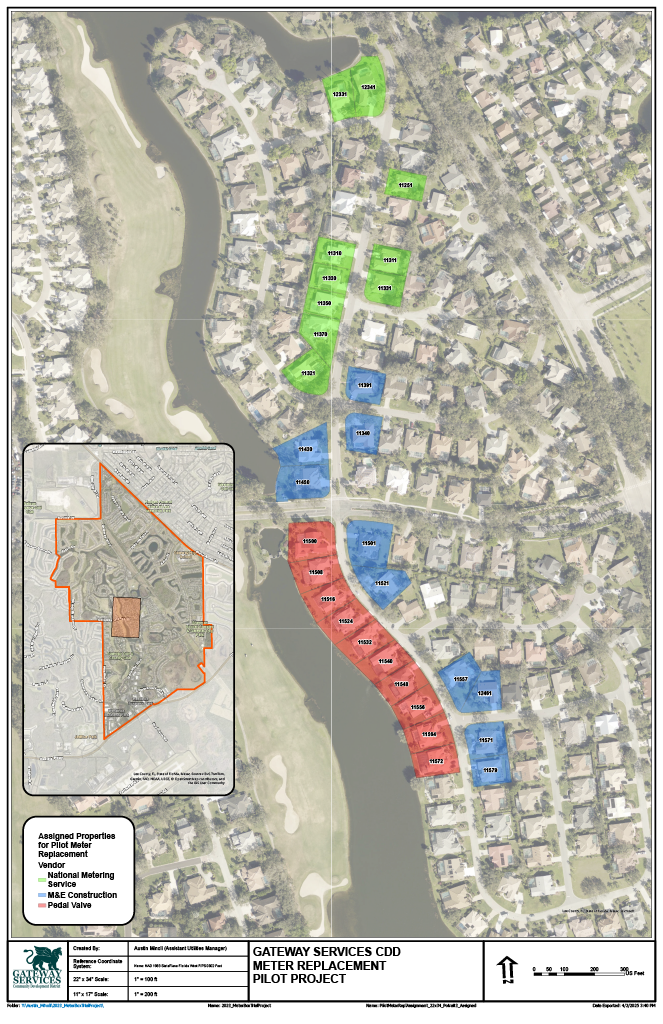
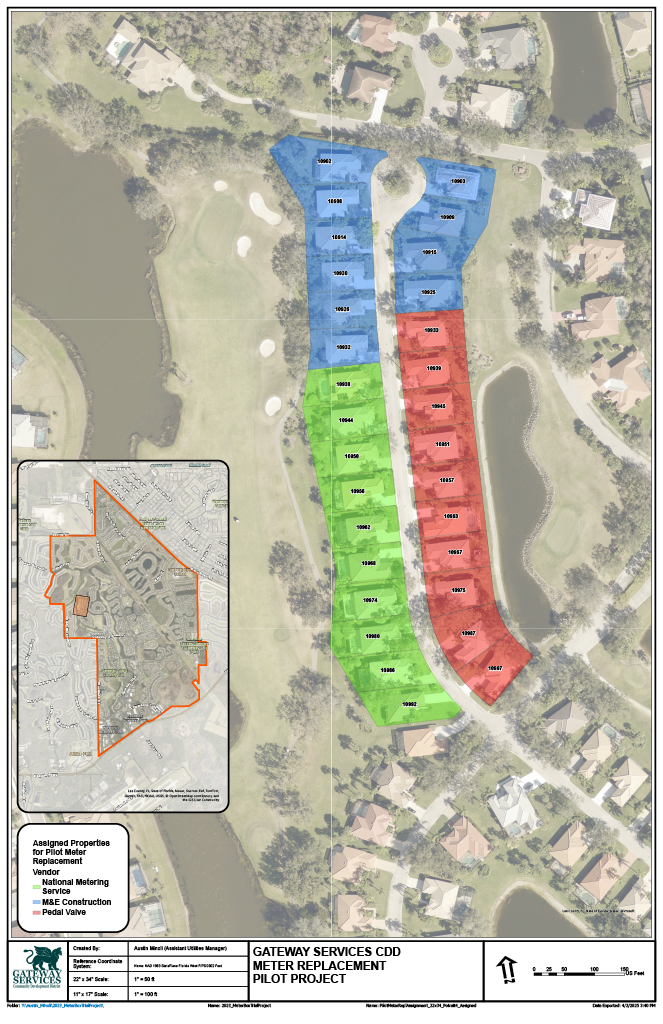
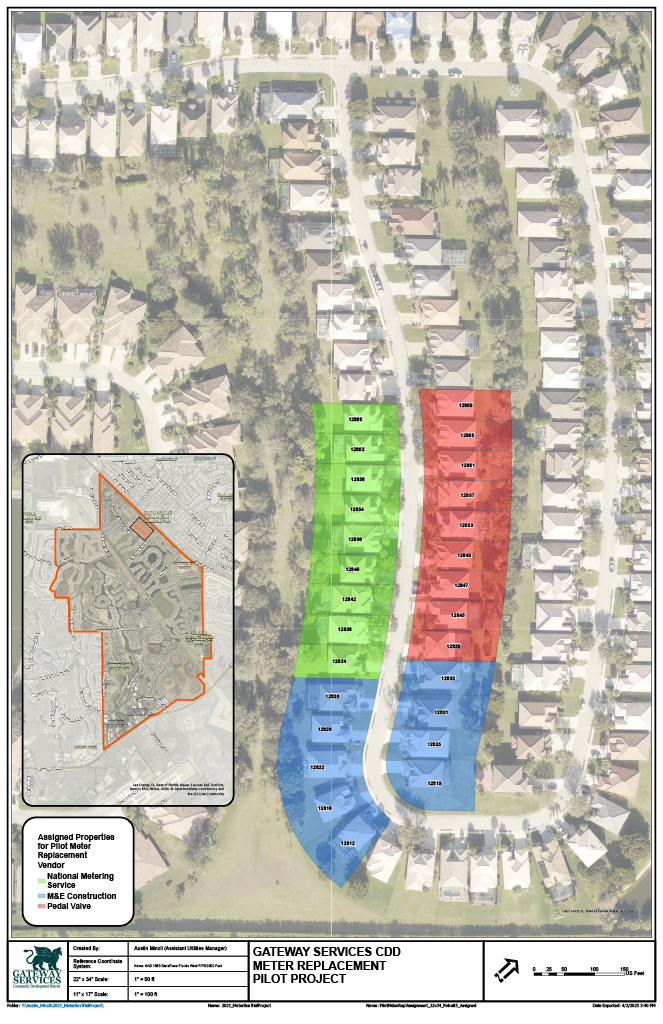

How long will installation take at my property?
Approximately 30 minutes.
Will my water be turned off during installation?
Yes, water will be temporarily turned off. A flush will be performed using your outdoor spigot afterward if available.
Do I need to be home for the installation?
No, you do not need to be home. Installers will only access the meter box located outside your home.
Will the contractor need access inside my home?
No, all work will be done externally at the meter location.
How will I be notified when my meter is going to be replaced?
You will receive an email notification. Please ensure your email address is up to date in our billing system through your customer portal or email customercare@gatewaydistrict.org
What if I have landscaping or hardscaping around my meter box?
There should be at least a 3-foot clearance around all utility assets. This was addressed during the previous meter box replacement phase. If obstructions remain, you may be contacted for removal.
What happens after the pilot phase is complete?
The District will evaluate the performance of each AMI meter system and select a vendor that best meets operational and customer needs. Properties involved in the pilot may receive a second meter changeout once the final vendor is chosen.
Will I get to keep the meter installed during the pilot?
No. All meters are the property of the Gateway Services CDD.
Can I opt out of the pilot program?
No. The District is upgrading metering infrastructure for all customers, including individually metered homes and master-metered communities such as condos and apartments.
Is this upgrade for both irrigation and potable water?
Yes, both irrigation and potable water meters are included in the project.
How is the project funded?
The pilot phase is being self-funded by the District using capital reserves. Full deployment of the Advanced Metering Infrastructure (AMI) system will be funded through a low-interest financing through the State Revolving Fund Loan. As a result, these costs are covered in your utility bill through rates, charges and fees.
What are the benefits of updating Cellular AMI meters?
AMI meters offer accurate meter readings and allow for leak detection, high usage alerts, and improved billing transparency. The District’s current AMI meter system is antiquated and inoperable. This transition eliminates the need for manual meter readings and helps identify infrastructure issues more quickly. Notifications can be set for high usage, low usage, no usage, leak detection and other identifiers as part of the new system.
How will the new meters help detect leaks or high usage?
AMI meters provide continuous usage data (frequent data intervals). During the pilot, the District can identify leaks or unusual spikes in usage and notify customers. In the future, a customer portal will allow residents to set alerts and monitor water use. Updated technology and communication allows consumers to select notification preferences and alerts.
Will I be able to see my water usage online?
Currently, usage reporting remains the same. Once the customer portal is upgraded after the pilot, customers will be able to view real-time usage data and receive custom notifications.
Will my water bill change?
Your bill may reflect more accurate readings. The District will monitor and evaluate billing data during the pilot to ensure accuracy. There will be no impact to your customer portal display until future software updates once a single vendor meter is selected.
How is my usage data protected?
AMI meters use secure, encrypted communication through a private network to transmit usage data. This data is not shared and is protected in line with industry standards.
Are AMI meters safe?
Yes. AMI meters emit low-level radio frequency similar to common devices such as cell phones, baby monitors, microwaves, WiFi routers, and garage door openers. They are safe for use in residential environments.
What should I do if I think my new meter isn’t working properly?
The pilot phase is designed to identify and resolve these types of issues. For a streamlined process and to ensure residents receive accurate information, please direct all questions regarding this project to the District via phone (239) 561-1313 (option 2) or online at gatewaydistrict.org/rfa.
For information about ongoing District projects, visit gatewaydistrict.org/districtprojects